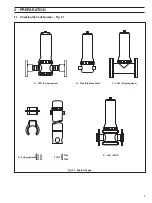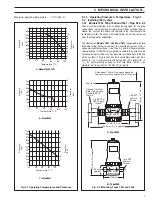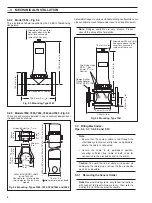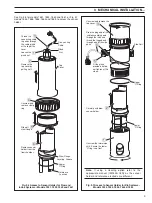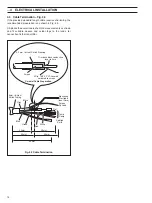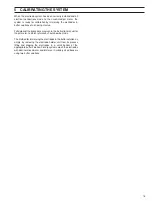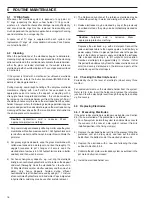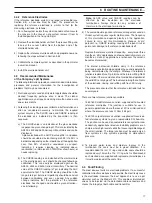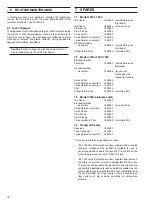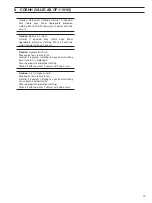
17
6
ROUTINE MAINTENANCE…
6.4.2
Reference Electrodes
If the reference electrode system is no longer serviceable (see
Section 6.5), a new one must be fitted. The procedure for
replacing the reference electrode is similar to that for the
measuring electrode, as follows:
1) For a flow system isolate the system to enable safe access to
the sensors. In the case of a dip system, remove it from its
installed position in the fixing clamp(s).
2) Remove the electrode holder unit from the process fitting, and
take out the sensor holder from the bottom end of the
electrode holder unit.
3) Replace the reference electrode with an appropriate new one,
following the steps outlined in Section 3.3.2.
4) Calibrate the complete system as described in the pH meter
instruction manual.
5) Install the electrode holder unit.
6.5
Recommended Maintenance
of the Company’s pH Systems
The following information provides a recommended maintenance
procedure and general information for the investigation of
problems that may be encountered.
1) Electrode systems used on dirty water applications should be
cleaned frequently, perhaps once a week. The cleaner
applications may not require cleaning more than once every
one or two months.
2) Following the cleaning process calibrate in buffer solutions as
often as considered necessary to maintain the required
system accuracy. The SLOPE value and CHECK reading of
the electrode pair, indicated by the transmitter, is then
assessed.
a) The SLOPE value is an indication of the glass electrode
response to a given change in pH. This is calculated by the
AX400, 4500 and 4600 Series pH transmitters and can be
displayed.
A glass electrode with a SLOPE value of 95% and above
should be considered as functioning well. 92% to 94% is
borderline depending on the importance of the application.
Less than 92% should be considered as suspect,
indicating it requires cleaning, as indicated above,
reactivated (i.e. immersed in 0.1M HCl for a few hours), or
needs replacing.
b) The CHECK reading is an indication of the electrical zero
of the electrode pair, so it should be checked following a
calibration. This can easily be displayed again on the
AX400, 4500 and 4600 Series transmitters. The nominal
value of the CHECK reading is 7pH, indicating the 0mV
equivalent to 7pH. The CHECK reading should be in the
range 6 to 8 pH but more importantly should be constant
between calibrations and over a period. Any sudden
change indicates that the potential of the reference
electrode has changed and should be given attention –
see 3) following.
Note
. SLOPE value and CHECK readings can be
affected by low insulation on the electrode
terminations. Always check for any evidence of
moisture in the electrode terminations.
3) The sealed double junction reference arrangement used on
this pH system requires regular maintenance. The frequency
of this maintenance depends greatly on the application.
Failure to carry out this maintenance changes its mV
potential, i.e. CHECK reading, causing drift, open circuit or
permanent damage to the reference electrode itself.
Replace the reference junction frequently – every two or three
months on ‘dirty’ applications and low conductivity waters, six
months on ‘cleaner’ applications, or whenever the ceramic
becomes discoloured.
The internal potassium chloride slurry in the reference
electrode is constantly being depleted in use and is potentially
being contaminated by the sample. Whenever the reference
junction is replaced (see Fig. 3.8) check the internal filling. Refill
the junction if there is evidence of contamination, depletion of
the solid KCl, or drying out. This involves draining the contents
of the electrode, rinsing, and refilling with fresh KCl slurry.
This procedure ensures that the reference electrode lasts for
several years.
There are two reference junctions available:
•
1360 180 Small Reference Junction: supplied with all sealed
reference electrodes. The junction is suitable for use in
general applications where the loss of KCl is minimised and
where the pressure can reach 10bar (145 psi).
•
1360 190 Large Reference Junction: supplied with reservoir-
fed reference systems to give a reproducible KCl flow rate.
The junction can be used on sealed reference system on low
conductivity applications to reduce instability problems or on
sample where high level of solids that cause rapid blockage of
the small junction. The large junction must be used only on
flow systems or dip systems operating at atmospheric
pressure.
4) To prevent water leaks and moisture ingress at the
termination, the seals must be in good condition. It is
recommended that all ‘O’ rings and cable seals should be
replaced every 12 months. The ‘O’ ring, which is fitted around
each electrode, are supplied with replacement electrodes, so
it must be replaced at the same time.
6.6
Fault Finding
The most obvious faults are electrode problems. If a successful
calibration in buffer solutions is not possible, the most likely cause
is the electrodes. However, the best approach is to use a pH
simulator such as the Model 2410. This enables simulated pH
values to be injected via the detachable cable connectors and
checks the integrity of both cable and transmitter.

